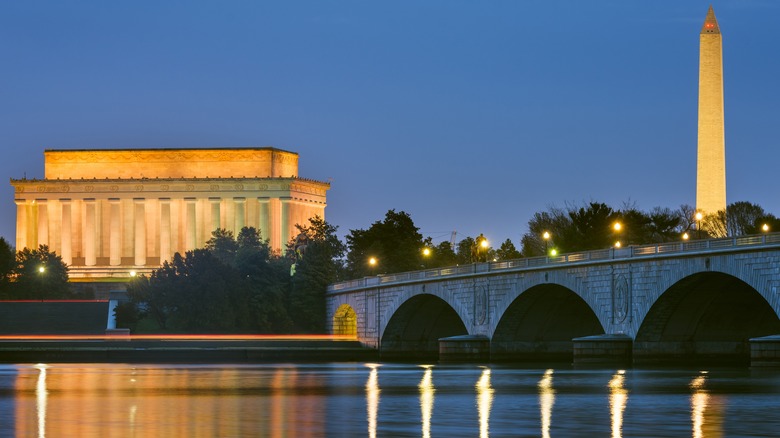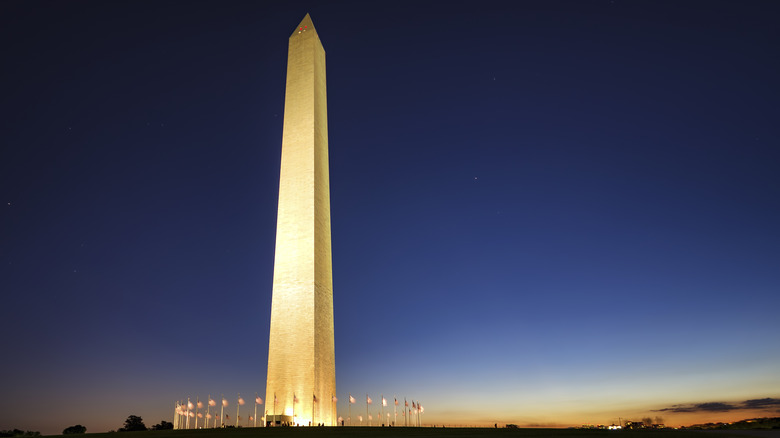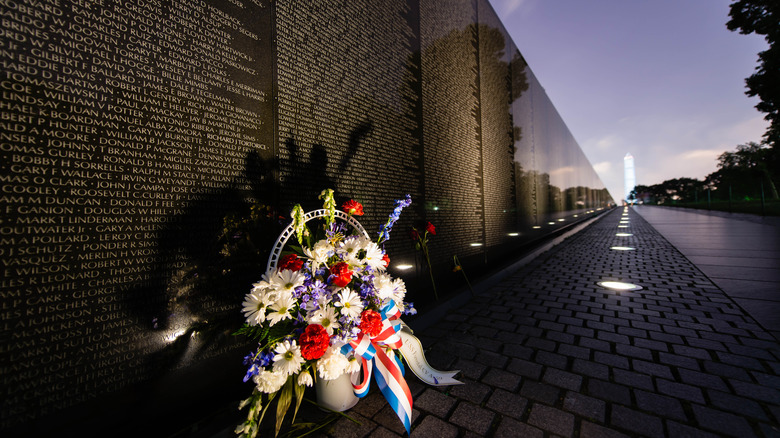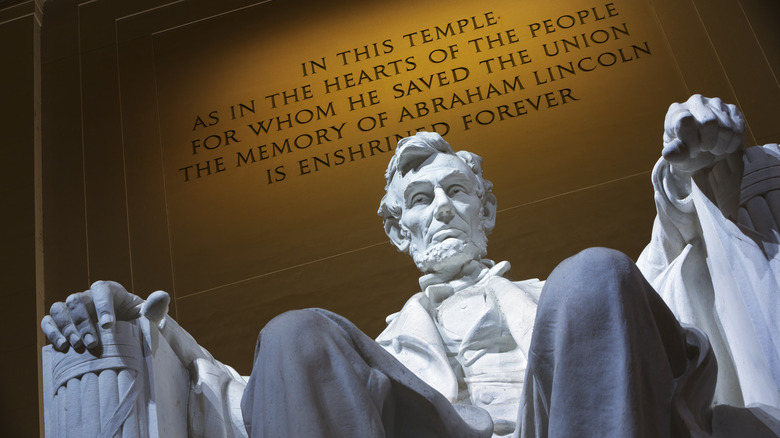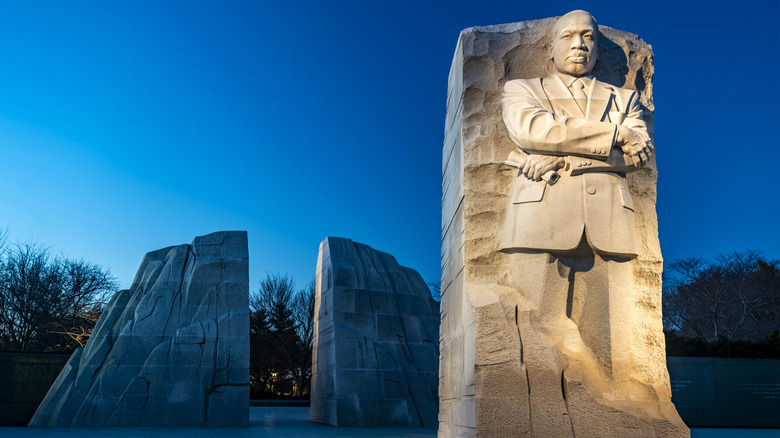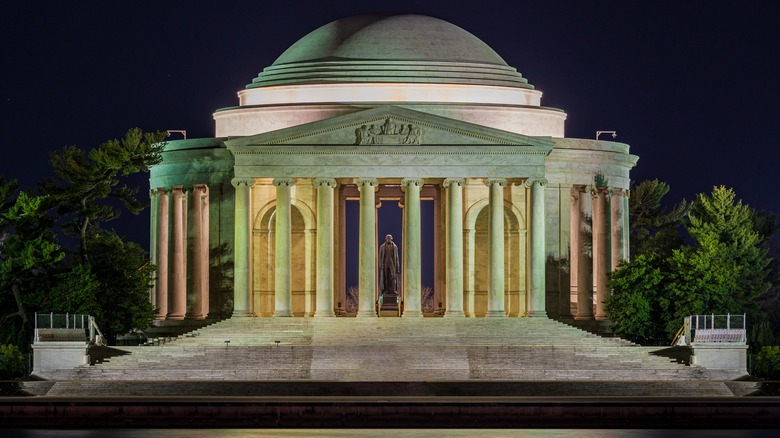5 Iconic Tourist Attractions In Washington, D.C. That Are Better To Visit At Night
For many visitors, the first order of business on a trip to Washington, D.C., will be a whirlwind tour of famous monuments and memorials. Over 100 such landmarks are localized in and around "America's front yard," the National Mall, which is open 24 hours with a visible security presence. This gives you the option of seeing the most well-known, impactful monuments at night, and some might say that's the better option.
During the summer, it's a way to mitigate the heat. The rest of the year, it's a way to avoid the crowds, which usually thin out after dark. You'll be able to see the monuments lit up, and you might find a sense of calm come over the Mall. That isn't always there during the day when tour buses are unloading and it's bustling with people. Being able to hear yourself think as you contemplate American history could make for a more meaningful experience. At the same time, if you go after sunset, you can get some beautiful blue-hour photos that will do the memorials justice.
Twilight in the nation's capital can be enchanting, though you shouldn't necessarily expect to be free of all humidity and humanity on the Mall. With D.C. recording hotter and hotter summers, it's not unheard of for it to have some nights with a low temperature of 80 degrees Fahrenheit. There are also still tour groups that descend nightly, like the ones on Old Town Trolley's "Monuments by Moonlight" tour. That said, you might have a more relaxing, comfortable experience if you visit these five D.C. attractions at night.
Washington Monument
Where better to start your evening or night tour than a monument to the person who gives Washington, D.C., its very name? Dedicated to George Washington, the first U.S. president and the face on the one-dollar bill, the Egyptian-style Washington Monument is lit up every night. With a height of 555 feet, it holds the Guinness World Record for "tallest obelisk," so you can see it from all around town. This makes it a good visual beacon for a night tour.
In contrast to the memorials on this list, the Washington Monument has a firm closing time (5 p.m.), and it requires a timed reservation if you want to take the elevator up to its observation deck. Despite these restrictions, the monument makes the cut here for one simple reason: its gorgeous sunset views. In December, when daylight hours are shorter, the sun goes down in D.C. as early as 4:45 p.m. If you time it right, you can be up at the top of the monument when that happens.
The last entry of the day is at 4 p.m. That gives you time to see the transition from day to night as you survey all of Washington from an elevated position. To the west, you might see planes fly in over the twinkling city lights, casting mirrored shapes in the Lincoln Memorial Reflecting Pool. The small, eye-like pairs of windows looking out each side of the pyramidion also have views of the White House, the U.S. Capitol, and other important landmarks. You can reserve your $1 tickets for the Washington Monument 30 days in advance via recreation.gov.
Vietnam Veterans Memorial
The most sobering landmark you'll encounter on the National Mall is the Vietnam Veterans Memorial. It centers on a long, black granite wall, which has two wings that come together in a wide "V" between the Washington Monument and the Lincoln Memorial. On the wall, is a list of 58,318 names: all the members of the armed services who were killed in action or went missing during the Vietnam War.
At night, the wall is illuminated by lights on the walkway alongside it, and you can still see reflections on it, superimposing the present over a past etched in stone. Being there after dark also gives you a chance to reflect more internally without all the daylight distractions. The solemn weight of the wall, effectively a mass tombstone, is accentuated by the sight of flowers, American flags, and other tokens of remembrance left for the lives lost.
The names begin in 1959 and end in 1975, with the wall being designed so that they start on the right, resume on the left, and meet in the middle. When the memorial was first dedicated in 1982, it took 56 hours to read all the names in a ceremony at Washington National Cathedral. Jan Scruggs, the veteran who founded the memorial, was originally inspired to see one built by the Oscar-winning Vietnam war movie, "The Deer Hunter." Today, the Vietnam Veterans Memorial site includes an evocative statue of Three Servicemen in jungle fatigues, along with the only memorial to military women on the National Mall: the Vietnam Women's Memorial.
Lincoln Memorial
With a design influenced by the Parthenon in Athens, Greece, the Lincoln Memorial is perhaps the most impressive landmark on the National Mall, both inside and out. The exterior, lit brilliantly at night, features three dozen Doric columns, one for every U.S. state at the time of the 16th president's death. Recessed lights in the interior shine down on a 175-ton marble likeness, seated under the inscription: "In this temple, as in the hearts of the people for whom he saved the Union, the memory of Abraham Lincoln is enshrined forever."
Time and again, historians have ranked Lincoln as the greatest president for his ability to hold the country together through the Civil War and bring an end to slavery. The Gettysburg Address is also inscribed on the memorial chamber wall, with his words, "The world will little note nor long remember what we say here," now writ large so every visitor can see. The Lincoln Memorial is the first place covered in our ultimate guide to Washington, D.C.'s memorials, and per the National Parks Service, it's the most-visited site on the National Mall.
The Reflecting Pool in front of the memorial enhances its beauty at night, particularly as you're headed down the steps and you have a view straight down to the Washington Monument. Across town, Ford's Theatre, the site of Lincoln's assassination in 1865, has an after-hours tour where history buffs can see artifacts like the blood-stained pillow where he lay dying. In the Lincoln Memorial, he lives larger-than-life, and he's not the only martyr to do so in the vicinity.
Martin Luther King, Jr. Memorial
Besides presidential inaugurations (which could be honorable or ignoble, depending on your view of each president), the National Mall is where great moments in American history like Martin Luther King, Jr.'s "I Have a Dream" speech have taken place. King delivered that speech at the Lincoln Memorial during the March on Washington, and 48 years later, he had his own memorial dedicated right nearby. The Martin Luther King, Jr. Memorial is one of the newer monuments to arise in D.C. circa 2011. It gives solid granite expression to a line from the slain civil rights leader's speech: "Out of the mountain of despair, a stone of hope."
That line is engraved on the 30-foot statue that forms the centerpiece of the Martin Luther King, Jr. Memorial. The statue depicts King standing with rolled papers on the "stone of hope," with a bifurcated "mountain of despair" behind him — as if it broke in two when he emerged from it. This memorial is surrounded by cherry blossoms, which makes it an especially beautiful spot to visit when they're illuminated at night during the spring bloom. The bloom usually overlaps with the anniversary of King's assassination on April 4, 1968.
On the north and south wall around the memorial, you'll see other lines from King, such as the oft-quoted, "The arc of the moral universe is long, but it bends toward justice." The visitor is also left to ponder words of wisdom from his "Letter from a Birmingham Jail." One line from a 1967 anti-war conference helps further situate King within the same historical period as the names on the Vietnam Veterans Memorial.
Thomas Jefferson Memorial
Across the Tidal Basin reservoir from the MLK Memorial is the Thomas Jefferson Memorial. Honoring the third U.S. president, this domed, white-marble memorial draws inspiration from the Pantheon in Italy, though its portico features Ionic rather than Corinthian columns. If you've done the Caesar Shuffle through Rome's iconic sites — including the Pantheon and the Colosseum — consider this the last stop on the nighttime Washington Shuffle.
Going by the National Park Service's definition of the National Mall, the Jefferson Memorial acts as the area's southernmost boundary. Since it's on the outer edge, far from the other monuments, it takes you away a bit from the area that's safest at night. In our guide for what to skip in D.C. and what to do instead, we recommend cycling or taking an Uber cab to the Jefferson Memorial. Otherwise, it's about a 45-minute walk from here to the Washington Monument, and stopping at the other monuments on this list will stretch that out even longer.
The cherry blossoms around the Tidal Basin aren't lit up at night anymore, but the Jefferson Memorial is. In its open-air rotunda, you'll gaze up at a 19-foot bronze statue of Thomas Jefferson, holding the Declaration of Independence. An excerpt from the document, mostly written by Jefferson, is carved on the wall with quotes from him. You may know the words by heart already if you memorized the Declaration in school. They speak of people being "created equal" and endowed with "inalienable rights" like "life, liberty, and the pursuit of happiness." Considering these words in view of American history is a good way to end the night in Washington, D.C.
